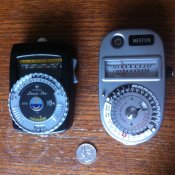Helios 1984
Member
Hi folks,
I am an amateur who's looking for a vintage light meter for practical use.
Here's what I understand so far (Correct me if I did a mistake):
Selenium = No battery, variety of cool looking meters available for dirt price, may or may not work properly if the selenium cell is beginning to fail.
CdS = Require infamous Mercury battery that are no longer produced for the past 20 years, battery conversion kit available $$, may or may not require re-calibration.
Silicon Blue = Require 9v battery that are available everywhere, more expensive.
I already scrolled down the net to find THE meter, here's my list:
9v Battery
- Gossen Profisix aka Luna-Pro SBC
- Gossen Lunasix F aka Luna-Pro F
Mercury Battery
- Gossen Lunasix 3 aka Luna Pro
- Weston Ranger 9
Where should I look to find those devices, what should I avoid, which one is the most reliable ?
Any recommendation will be welcomed.
thank you for your time.
I am an amateur who's looking for a vintage light meter for practical use.
Here's what I understand so far (Correct me if I did a mistake):
Selenium = No battery, variety of cool looking meters available for dirt price, may or may not work properly if the selenium cell is beginning to fail.
CdS = Require infamous Mercury battery that are no longer produced for the past 20 years, battery conversion kit available $$, may or may not require re-calibration.
Silicon Blue = Require 9v battery that are available everywhere, more expensive.
I already scrolled down the net to find THE meter, here's my list:
9v Battery
- Gossen Profisix aka Luna-Pro SBC
- Gossen Lunasix F aka Luna-Pro F
Mercury Battery
- Gossen Lunasix 3 aka Luna Pro
- Weston Ranger 9
Where should I look to find those devices, what should I avoid, which one is the most reliable ?
Any recommendation will be welcomed.
thank you for your time.











